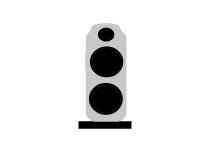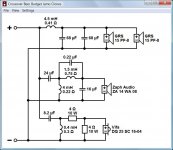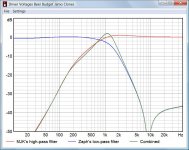or which numbers is way out,
Mattias
Hi, look at your numbers, you tell me which is wrong, rgds, sreten.
I upload picture how the speaker could look like, maybe around 1,1meter in height, curved in plexiglass with big metal foot as stand.
Is it important which distance it is from the different drivers?
Is it maybe possible to have a 8 inch and a 15 inch instead of two 15 inch, and what do you think of the result?
Is it important which distance it is from the different drivers?
Is it maybe possible to have a 8 inch and a 15 inch instead of two 15 inch, and what do you think of the result?
Attachments
Comparing the alpha 15 to the GW 15, via specs on paper as well as a real build in H-frames, the GW 15" does extend lower, but at the huge cost of
efficiency (which is so dear for OB use) and also the max SPL possible. On specs, the GW 15 has about 10db lower efficiency and also lower peak power handling than alpha 15. Having at least two GW 15 on one side is a minimum. OTOH, a single alpha 15 each side can provide satisfying max SPL levels.
From practical experience, I started with the GW 15 in h-frame for the lure of "flat down to 30hz" (in contrast to the 40hz "only" for the alpha 15). But the Gw-15 bottomed out too soon even before the bass started to hit. 😡
When I "upgraded" to the alpha 15, there was a significant improvement of max SPL delivered. Afterall a kick drum also has to be "loud" enough to sound like one, and the single alpha on each side could do it without a sweat...the GW15 could not do it. Perhaps the better build quality and accordion suspension of pro woofers like alpha do have some benefits of better control, particularly in free air OB applications. The GRS woofer looks almost the same as the GW15 for OB apps and would likely behave the same acoustically. There are supplemental monopole subs for sub-40hz, but I rarely need them, allowing a smaller overall package than using 2 GW per side on OB and still going down to only 30hz at less than realistic max SPL levels.
Hi,
I don't like the goldwood drivers and have made it pretty clear the
GRS drivers are my preferred choice. You don't have a leg to stand
on in asserting the GRS's will be similar to the GW's by assumption.
Two GRS15's hit the efficiency target, the claimed linear Xmax is similar
to a Alpha 15 and two of them should do a lot better than one Alpha 15.
But as originally stated, it is a paper exercise, take it or leave it.
rgds, sreten.
Last edited:
Hi,
Anything informative to add rather than just opinionated criticism ?
rgds, sreten.
Already done previously : http://www.diyaudio.com/forums/mult...n-10-000-jamo-open-baffles-5.html#post2795355
yesMaybe i could make the speaker a little lower in height, and only use one 15",
nowould it sound as good with one 15"?
not necessary. See http://www.diyaudio.com/forums/multi-way/147812-big-passive-ob-project.htmlI have seen that the woofer need to be between 1-2 in qts.
It was my daily speaker.
Difficult to find cheap and look gorgeous. You pay look and good quality construction.So do you know a better choice then the Grs woofer, maybe a one that also look better?
I have the idea you should make it build for you.
Perhaps the eminence deltalite ii 2510 ? or a beyma/18sound woofer
Looks good for me, better geometry than the Jamo.I upload picture how the speaker could look like, maybe around 1,1meter in height, curved in plexiglass with big metal foot as stand.
noIs it important which distance it is from the different drivers?
8" as mid, yes with 300/400Hz crossover frequency. Also consider a 7".Is it maybe possible to have a 8 inch and a 15 inch instead of two 15 inch, and what do you think of the result?
drivers
Hi
I was thinking a full range 8inch 93,5db sensitivity that i found that should be really good.
I was thinking two 15" inch drivers also, but if i would contact a manufacture, what would be the exact specs to match the fullrange 8inch 93,5db speaker?
So maybe they could make one but i need your "dream specs" on a 15" woofer for ob that match the 93,5db driver, does the 15" woofer need to have 100db sensitivity then? Best QTS, FS number, size of magnet etc.
And i will see if they could make one
Hi
I was thinking a full range 8inch 93,5db sensitivity that i found that should be really good.
I was thinking two 15" inch drivers also, but if i would contact a manufacture, what would be the exact specs to match the fullrange 8inch 93,5db speaker?
So maybe they could make one but i need your "dream specs" on a 15" woofer for ob that match the 93,5db driver, does the 15" woofer need to have 100db sensitivity then? Best QTS, FS number, size of magnet etc.
And i will see if they could make one
Hi,
General waffle about OB design is off topic in this thread.
Best to discuss such things elsewhere. If you don't like
the Jamo's or a budget clone of them fair enough but
don't moan about it here as though its useful, it isn't.
rgds, sreten.
General waffle about OB design is off topic in this thread.
Best to discuss such things elsewhere. If you don't like
the Jamo's or a budget clone of them fair enough but
don't moan about it here as though its useful, it isn't.
rgds, sreten.
i have been looking woofer in 15 inch.
i have found two woofers, neodymium in 15inch, from manufacture.
Spl 99db on both, qts is 0,51 and the other is 0.22.
Is the one with 0.51 better, and is 0.51 good enough?
Neo magnet should better then old school magnet?
i have found two woofers, neodymium in 15inch, from manufacture.
Spl 99db on both, qts is 0,51 and the other is 0.22.
Is the one with 0.51 better, and is 0.51 good enough?
Neo magnet should better then old school magnet?
Just made a simulation of the Jamo clones proposed by sreten:
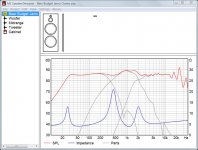
The result is not bad at all for being a pure theoretical combination of two existing designs. Only the midrange differs from the expected response. The reasons are:
- Open baffle is not infinite baffle. Edge diffraction plays an important role and must not be neglected.
- Adding a high-pass filter boosts the midrange (band-pass gain).
Thus some tuning in the midrange seems to be necessary, but then the Jamo clones will work fine.

The result is not bad at all for being a pure theoretical combination of two existing designs. Only the midrange differs from the expected response. The reasons are:
- Open baffle is not infinite baffle. Edge diffraction plays an important role and must not be neglected.
- Adding a high-pass filter boosts the midrange (band-pass gain).
Thus some tuning in the midrange seems to be necessary, but then the Jamo clones will work fine.
Attachments
Just made a simulation of the Jamo clones proposed by sreten:
The result is not bad at all for being a pure theoretical combination of two existing designs. Only the midrange differs from the expected response. The reasons are:
- Open baffle is not infinite baffle. Edge diffraction plays an important role and must not be neglected.
- Adding a high-pass filter boosts the midrange (band-pass gain).
Thus some tuning in the midrange seems to be necessary, but then the Jamo clones will work fine.
Is that software free to use ? Did you try estimating the max SPL possible with 2 GRS 15" drivers. Thanks.
Just made a simulation of the Jamo clones proposed by sreten:
View attachment 319562
The result is not bad at all for being a pure theoretical combination of two existing designs. Only the midrange differs from the expected response. The reasons are:
- Open baffle is not infinite baffle. Edge diffraction plays an important role and must not be neglected.
- Adding a high-pass filter boosts the midrange (band-pass gain).
Thus some tuning in the midrange seems to be necessary, but then the Jamo clones will work fine.
Hi,
I'm having some difficulty in understanding your sims general midrange boost.
I can't see how it it boosts the 500Hz to 2KHz range by around 3dB. For
sure open baffle is not inifinite baffle, but I can't work out at all how
you get such a change from a flat inwall response, the physics ?
rgds, sreten.
Is that software free to use ? Did you try estimating the max SPL possible with 2 GRS 15" drivers. Thanks.
It's a speaker simulation program I'm writing myself. I just have implemented the open baffle simulation these days. It will not be free, but shareware (free for 30 days). The first release is still pending.
The maximum SPL is:

Hi,
I'm having some difficulty in understanding your sims general midrange boost.
I can't see how it it boosts the 500Hz to 2KHz range by around 3dB. For
sure open baffle is not inifinite baffle, but I can't work out at all how
you get such a change from a flat inwall response, the physics ?
rgds, sreten.
The baffle step can easily make 3 dB gain at some frequencies. The actual behaviour is difficult to estimate, only a simulation can tell. I'm very sorry for not having a better explanation, but that's all I know...
Maybe a simulation without high-pass filter in the midrange helps to understand. It shows the baffle step only, no band-pass gain involved:
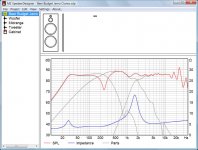
And for comparison a simulation of Zaph's ZA5 (without baffle step):
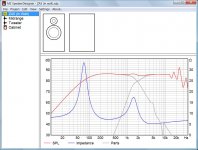
Hi,
Old thread But FWIW MJKs x/o is supposed to take care of the
baffle hump and his driver mounting positions are more sensible
than central for the mid and treble units.
A simulation without the high pass doesn't help. Both the mid high
pass and bass low pass are modified by the baffle hump in the basic
scheme of things, the high pass is higher, and the low pass lower to
effectively equalise the hump is the fundamental idea of MJKs x/o.
I can't see any evidence whatsoever of the bass to
mid x/o in the impedance plot, i.e. something is wrong.
Sims of the bass on its own and with the low pass (4 ohm modified)
and the mid on its its own and with the high pass would be useful.
For a 20" wide baffle assume the mid centre is 12" from one side
(8" the other) and 10" from the top for the baffle response.
rgds, sreten.
Old thread But FWIW MJKs x/o is supposed to take care of the
baffle hump and his driver mounting positions are more sensible
than central for the mid and treble units.
A simulation without the high pass doesn't help. Both the mid high
pass and bass low pass are modified by the baffle hump in the basic
scheme of things, the high pass is higher, and the low pass lower to
effectively equalise the hump is the fundamental idea of MJKs x/o.
I can't see any evidence whatsoever of the bass to
mid x/o in the impedance plot, i.e. something is wrong.
Sims of the bass on its own and with the low pass (4 ohm modified)
and the mid on its its own and with the high pass would be useful.
For a 20" wide baffle assume the mid centre is 12" from one side
(8" the other) and 10" from the top for the baffle response.
rgds, sreten.
Last edited:
Hi sreten,
The combination of MJK's high-pass filter and Zaph's low-pass filter in the midrange section unfortunately does not simply multiply two independent transfer functions. Interaction actually causes a corrupted band-pass response, which deviates significantly from the desired transfer function and makes the midrange too loud after all.
The combination of MJK's high-pass filter and Zaph's low-pass filter in the midrange section unfortunately does not simply multiply two independent transfer functions. Interaction actually causes a corrupted band-pass response, which deviates significantly from the desired transfer function and makes the midrange too loud after all.
Attachments
Hi sreten,
The combination of MJK's high-pass filter and Zaph's low-pass filter in the midrange section unfortunately does not simply multiply two independent transfer functions. Interaction actually causes a corrupted band-pass response, which deviates significantly from the desired transfer function and makes the midrange too loud after all.
Hi,
I can't argue with that, the x/o points are relatively near.
Active bi-amping is the way to go IMO, passive mid/treble.
rgds, sreten.
- Status
- Not open for further replies.
- Home
- Loudspeakers
- Multi-Way
- Beer budget "Version" of $10,000+ Jamo Open Baffles
